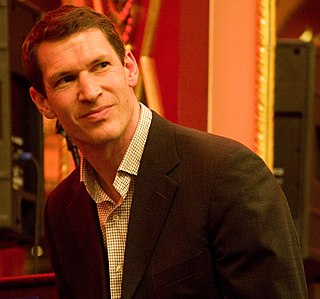
Photojournalism is journalism that uses images to tell a news story. It usually only refers to still images, but can also refer to video used in broadcast journalism. Photojournalism is distinguished from other close branches of photography by having a rigid ethical framework which demands an honest but impartial approach that tells a story in strictly journalistic terms. Photojournalists contribute to the news media, and help communities connect with one other. They must be well-informed and knowledgeable, and are able to deliver news in a creative manner that is both informative and entertaining.

Henri Cartier-Bresson was a French artist and humanist photographer considered a master of candid photography, and an early user of 35mm film. He pioneered the genre of street photography, and viewed photography as capturing a decisive moment.

Eve Arnold, OBE (honorary), FRPS (honorary) was an American photojournalist, long-resident in the UK. She joined Magnum Photos agency in 1951, and became a full member in 1957. She was the first woman to join the agency.

Ara Güler was an Armenian-Turkish photojournalist, nicknamed "the Eye of Istanbul" or "the Photographer of Istanbul". He was "one of Turkey's few internationally known photographers".
Grace Robertson was a British photographer who worked as a photojournalist, and published in Picture Post and Life. Her photographic series, including "Mother's Day Off" (1954) and "Childbirth" (1955), mainly recorded ordinary women in postwar Britain.
Photography Studies College, commonly abbreviated to PSC, is a privately owned independent tertiary photography college established in 1973, located in Melbourne, Victoria, Australia.

Timothy Alistair Telemachus Hetherington was a British photojournalist. He produced books, films and other work that "ranged from multi-screen installations, to fly-poster exhibitions, to handheld device downloads" and was a regular contributor to Vanity Fair.

William Thomas Saunders (1832–1892) was a British-born photographer who settled in China and became the leading photographer in Shanghai during the late Qing dynasty. He was the first photographer known to produce hand-coloured photographs in China.
Lu Guang (卢广) is a Chinese independent photojournalist. His work consists of large documentary projects on social, environmental, and economic issues, exposing the lives of "people on the margins of Chinese society: coal miners, drug addicts, HIV patients." His stories on pollution and environmental destruction cover topics traditionally under-reported due to the risk of punishment by the Chinese government.
Sam Tata was a photographer and photojournalist.
Jean-Pierre Laffont is a French-American photojournalist, born in Algeria, based in New York City. He was the founding member of Gamma USA and Sygma, the largest photography agency in the world, which in 1999 was acquired by the Corbis Corporation.

Lang Jingshan, also romanized as Long Chin-san and Lang Ching-shan, was a pioneering photographer and one of the first Chinese photojournalists. He has been called "indisputably the most prominent figure in the history of Chinese art photography", and the "Father of Asian Photography". He joined the Royal Photographic Society in 1937 and gained his Associateship in 1940 and Fellowship in 1942. and in 1980, the Photographic Society of America named him one of the world's top ten master photographers. He was the first Chinese photographer to take artistic nude shots, and was also known for the unique "composite photography" technique he created.

Lai Afong was a Chinese photographer who established Afong Studio, considered to be the most successful photographic studio in the late Qing Dynasty. He is widely acknowledged as the most significant Chinese photographer of the nineteenth century.

Sha Fei was a Chinese photojournalist and war photographer best known for his work with the Chinese Communist Party during the Second Sino-Japanese War (1937–45). Born Situ Chuan (司徒传), he took the pseudonym Sha Fei, that is, a grain of sand in the sky of his country. He has been called "one of the most admired Leftist photographers in China during the wartime years of 1937–1949", and "one of the most influential photographers of his generation". His "warm, dramatic, and ideologically-charged photographic presentations were emulated for decades thereafter".
Wang Wusheng was a Chinese photographer known for his black-and-white photographs of Mount Huangshan.
Liu Heung Shing is a Chinese-American, Pulitzer Prize winner former Associated Press photojournalist and photographer.
Guo Yingguang is a Chinese photographer. Her creations deal with social problems of contemporary China: women to marry, arranged marriages and pseudo-intimacy between husbands and wives victims of such marriages.
Xiao Zhuang, previously named Zhuang Dongying (庄冬莺), is a Chinese photographer and photo editor.

Liang Shitai 梁时泰 – also known as Liang Seetay – was one of the foremost portrait photographers working in China in the late Qing dynasty. The artist specialized in portraits of high-ranking officials, and photographs that appealed to Chinese clients interested in literati painting. As one of the first photographers of prominent Qing Dynasty officials and other distinguished citizens, Liang Shitai's work convinced the Qing court to embrace photography as an artistic medium for the first time. He established his studio in Hong Kong in the early 1870s, then relocated to Shanghai in the late 1870s, and later to Tianjin in the 1880s. Liang Shitai's photographs are among the most historically important and visually exquisite of their time.

Thomas Child (1841-1898) was an English photographer and engineer best known for his pioneering photography work in China. Child produced a large body of photographs during his time in Beijing in the 1870s and 1880s, a time when virtually no other photographers operated in the city. During the two decades he spent in China, Child compiled the earliest comprehensive photographic catalogue of the customs, architecture, and people of late Qing dynasty Beijing. A keen photographer of architecture, some of Child's images are among the earliest and the only known photographic records of their architectural subjects.











